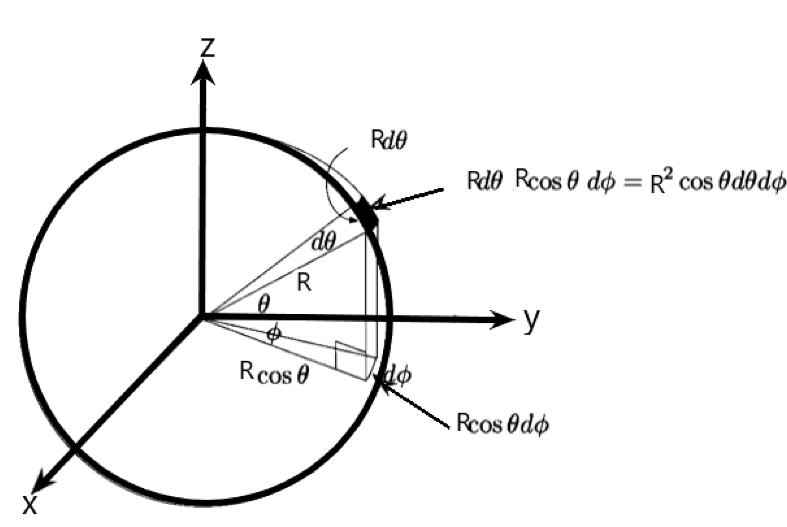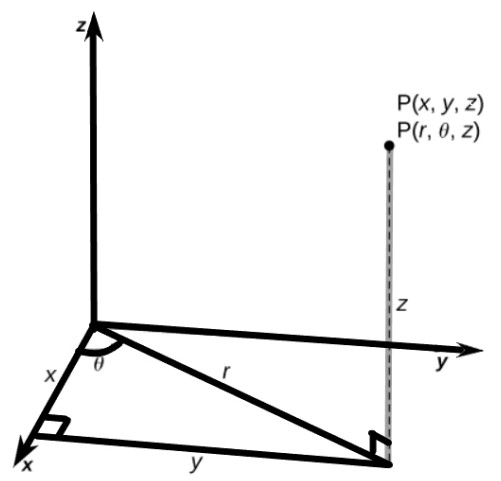
Use the spherical \[(r,\theta ,\phi )\], polar and cylindrical coordinates to answer the following:
a) Calculate the i) volume ii) Surface area of a sphere of radius R.
b) Calculate the volume and surface area of a cylinder of radius R and length L using integration method. (Use dA and dV elements in their respective coordinate systems).
Answer
557.4k+ views
Hint: We can use the different coordinate systems to calculate the area and volume of a given shape by using proper methods and substitutions. The integration method is much easier than the manual adding of elements to get a total sum. We can use it for all the coordinate systems.
Complete answer:
Let us calculate the volume and surface area of the sphere and cylinder using the appropriate coordinate systems.
a)Volume and Surface area of a sphere of radius R.2
Consider a sphere of radius R as given below:

i) We can calculate the volume of it using the spherical coordinate system as –
We should know the conversion from rectangular to spherical coordinates as –
\[{{r}^{2}}={{x}^{2}}+{{y}^{2}}+{{z}^{2}}\]
Now the volume element dV is given by as
\[dV={{r}^{2}}\sin \phi drd\theta d\phi \]
We can do the triple integration of the above element with proper limits as –
\[\begin{align}
& {{r}^{2}}={{x}^{2}}+{{y}^{2}}+{{z}^{2}} \\
& \Rightarrow dV={{r}^{2}}\sin \phi drd\theta d\phi \\
& Volume,V=\int{\int{\int{{{r}^{2}}}}}dV \\
& \text{By substituting for dV,} \\
& \Rightarrow \text{Volume,}V=\int_{0}^{R}{dr\int_{0}^{\pi }{{{r}^{2}}\sin \theta d\theta }\int_{0}^{2\pi }{d\phi }} \\
& \Rightarrow \text{Volume,}V=\int_{0}^{R}{{{r}^{2}}}dr\int_{0}^{\pi }{\sin \theta d\theta }\int_{0}^{2\pi }{d\phi } \\
& \Rightarrow \text{Volume,}V=-\dfrac{{{R}^{3}}}{3}(-1-1)(2\pi ) \\
& \therefore V=\dfrac{4}{3}\pi {{R}^{3}} \\
\end{align}\]
The volume of the sphere is \[\dfrac{4}{3}\pi {{R}^{3}}\].
ii) We can find the surface area by integrating over the area element dA which is given as \[{{r}^{2}}\cos \theta d\theta d\phi \]. The surface will be given as –
\[\begin{align}
& \int{dA=}{{R}^{2}}\int_{-\dfrac{\pi }{2}}^{+\dfrac{\pi }{2}}{\cos \theta d\theta }\int_{0}^{2\pi }{d\phi } \\
& \Rightarrow \text{Surface area, }A={{R}^{2}}(\sin \dfrac{\pi }{2}-\sin (-\dfrac{\pi }{2}))(2\pi -0) \\
& \Rightarrow A={{R}^{2}}(1-1)(2\pi ) \\
& \therefore A=4\pi {{R}^{2}} \\
\end{align}\]
The surface area of the sphere is \[4\pi {{R}^{2}}\].
b) Now, let us use the cylindrical coordinates to find the surface area and volume of the cylinder of length L and radius R.

The cylindrical coordinate equivalent for the corner point P \[(r,\theta ,z)\] of the cylinder is as shown in the above figure.
We can find the Surface area of the cylinder with
\[\begin{align}
& r=R \\
& z=L \\
\end{align}\]
Where,
\[\begin{align}
& x=r\cos \theta \\
& y=r\sin \theta \\
& z=z \\
& \text{as,} \\
& \text{Surface area, }A=\int_{0}^{R}{dr\int_{0}^{2\pi }{d\theta }}\int_{0}^{L}{dz} \\
& \Rightarrow A=R(2\pi )L \\
& \therefore A=2\pi RL \\
\end{align}\]
Similarly, we can find the volume of the cylinder by using the given the method –
\[\begin{align}
& \text{Volume, }V=\int_{0}^{R}{r}\int_{0}^{2\pi }{d\theta \int_{0}^{L}{dz}} \\
& \Rightarrow V=\dfrac{{{R}^{2}}}{2}(2\pi )L \\
& \therefore V=\pi {{R}^{2}}L \\
\end{align}\]
Thus, we have found the surface areas and volumes of the sphere and the cylinder using the spherical and cylindrical coordinates respectively.
Note:
The rectangular coordinate is the most easily convertible to any other forms. The cylindrical coordinate is very much similar to the polar coordinates except for that it has a third coordinate. The coordinate systems used effectively makes the calculations much easier.
Complete answer:
Let us calculate the volume and surface area of the sphere and cylinder using the appropriate coordinate systems.
a)Volume and Surface area of a sphere of radius R.2
Consider a sphere of radius R as given below:

i) We can calculate the volume of it using the spherical coordinate system as –
We should know the conversion from rectangular to spherical coordinates as –
\[{{r}^{2}}={{x}^{2}}+{{y}^{2}}+{{z}^{2}}\]
Now the volume element dV is given by as
\[dV={{r}^{2}}\sin \phi drd\theta d\phi \]
We can do the triple integration of the above element with proper limits as –
\[\begin{align}
& {{r}^{2}}={{x}^{2}}+{{y}^{2}}+{{z}^{2}} \\
& \Rightarrow dV={{r}^{2}}\sin \phi drd\theta d\phi \\
& Volume,V=\int{\int{\int{{{r}^{2}}}}}dV \\
& \text{By substituting for dV,} \\
& \Rightarrow \text{Volume,}V=\int_{0}^{R}{dr\int_{0}^{\pi }{{{r}^{2}}\sin \theta d\theta }\int_{0}^{2\pi }{d\phi }} \\
& \Rightarrow \text{Volume,}V=\int_{0}^{R}{{{r}^{2}}}dr\int_{0}^{\pi }{\sin \theta d\theta }\int_{0}^{2\pi }{d\phi } \\
& \Rightarrow \text{Volume,}V=-\dfrac{{{R}^{3}}}{3}(-1-1)(2\pi ) \\
& \therefore V=\dfrac{4}{3}\pi {{R}^{3}} \\
\end{align}\]
The volume of the sphere is \[\dfrac{4}{3}\pi {{R}^{3}}\].
ii) We can find the surface area by integrating over the area element dA which is given as \[{{r}^{2}}\cos \theta d\theta d\phi \]. The surface will be given as –
\[\begin{align}
& \int{dA=}{{R}^{2}}\int_{-\dfrac{\pi }{2}}^{+\dfrac{\pi }{2}}{\cos \theta d\theta }\int_{0}^{2\pi }{d\phi } \\
& \Rightarrow \text{Surface area, }A={{R}^{2}}(\sin \dfrac{\pi }{2}-\sin (-\dfrac{\pi }{2}))(2\pi -0) \\
& \Rightarrow A={{R}^{2}}(1-1)(2\pi ) \\
& \therefore A=4\pi {{R}^{2}} \\
\end{align}\]
The surface area of the sphere is \[4\pi {{R}^{2}}\].
b) Now, let us use the cylindrical coordinates to find the surface area and volume of the cylinder of length L and radius R.

The cylindrical coordinate equivalent for the corner point P \[(r,\theta ,z)\] of the cylinder is as shown in the above figure.
We can find the Surface area of the cylinder with
\[\begin{align}
& r=R \\
& z=L \\
\end{align}\]
Where,
\[\begin{align}
& x=r\cos \theta \\
& y=r\sin \theta \\
& z=z \\
& \text{as,} \\
& \text{Surface area, }A=\int_{0}^{R}{dr\int_{0}^{2\pi }{d\theta }}\int_{0}^{L}{dz} \\
& \Rightarrow A=R(2\pi )L \\
& \therefore A=2\pi RL \\
\end{align}\]
Similarly, we can find the volume of the cylinder by using the given the method –
\[\begin{align}
& \text{Volume, }V=\int_{0}^{R}{r}\int_{0}^{2\pi }{d\theta \int_{0}^{L}{dz}} \\
& \Rightarrow V=\dfrac{{{R}^{2}}}{2}(2\pi )L \\
& \therefore V=\pi {{R}^{2}}L \\
\end{align}\]
Thus, we have found the surface areas and volumes of the sphere and the cylinder using the spherical and cylindrical coordinates respectively.
Note:
The rectangular coordinate is the most easily convertible to any other forms. The cylindrical coordinate is very much similar to the polar coordinates except for that it has a third coordinate. The coordinate systems used effectively makes the calculations much easier.
Recently Updated Pages
A man running at a speed 5 ms is viewed in the side class 12 physics CBSE

The number of solutions in x in 02pi for which sqrt class 12 maths CBSE

State and explain Hardy Weinbergs Principle class 12 biology CBSE

Write any two methods of preparation of phenol Give class 12 chemistry CBSE

Which of the following statements is wrong a Amnion class 12 biology CBSE

Differentiate between action potential and resting class 12 biology CBSE

Trending doubts
What are the major means of transport Explain each class 12 social science CBSE

Which are the Top 10 Largest Countries of the World?

Draw a labelled sketch of the human eye class 12 physics CBSE

How much time does it take to bleed after eating p class 12 biology CBSE

Explain sex determination in humans with line diag class 12 biology CBSE

When was the first election held in India a 194748 class 12 sst CBSE




